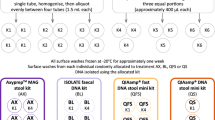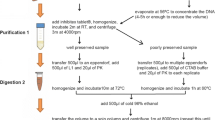Abstract
Faecal material has increasingly become an important non-invasive source of DNA for wildlife population genetics. However, DNA from faecal sources can have issues associated with quantity (low-template and/or low target-to-total DNA ratio) and quality (degradation and/or low DNA-to-inhibitor ratio). A number of studies utilizing faecal material assume and compensate for the above properties with minimal characterization of quantity or quality of target DNA, which can unnecessarily increase the risk of downstream technical problems. Here, we present a protocol which quantifies faecal DNA using a two step approach: (1) estimating total DNA concentration using a PicogreenTM fluorescence assay and (2) estimating target nuclear DNA concentration by comparing amplification products of field samples at suspected concentrations to those of control DNA at known concentrations. We applied this protocol to faecal material collected in the field from two species: woodland caribou (Rangifer tarandus) and swift fox (Vulpes velox). Total DNA estimates ranged from 6.5 ng/μl to 28.6 ng/μl (X = 16.2 ng/μl) for the caribou extracts and 1.0–26.1 ng/μl (X = 7.5 ng/μl) for the swift fox extracts. Our results showed high concordance between total and target DNA estimates from woodland caribou faecal extracts, with only 10% of the samples showing relatively lower target-to-total DNA ratios. In contrast, DNA extracts from swift fox scat exhibited low target DNA yields, with only 38% (19 of 50) of the samples showing comparative target DNA amplification of at least 0.1 ng. With this information, we were able to estimate the amount of target DNA entered into PCR amplifications, and identify samples having target DNA below a lower threshold of 0.2 ng and requiring modification to genotyping protocols such as multiple tube amplification. Our results here also show that this approach can easily be adapted to other species where faeces are the primary source of DNA template.




Similar content being viewed by others
References
Banks SC, Piggott MP, Hansen BD, Robinson NA, Taylor AC (2002) Wombat coprogenetics: enumerating a common wombat population by analysis of faecal DNA. Aust J Zool 50:193–204
Bellemain E, Taberlet P (2004) Improved non-invasive genotyping method: application to brown bear (Ursus arctos) feces. Mol Ecol Notes 4:519–522
Broquet T, Petit E (2004) Quantifying genotyping errors in non-invasive population genetics. Mol Ecol 13:3601–3608
Cullingham CI, Smeeton C, White BN (2006) Isolation and characterization of Swift Fox tetranucleotide microsatellite loci. Mol Ecol Notes (in press)
Dalèn L, Götherström A (2004) Identifying species from pieces of faeces. Conserv Genet 5:109–111
Ernest HB, Penedo CT, May BP, Syvanen M, Boyce WM (2000) Molecular tracking of mountain lions in the Yosemite Valley region in California: genetic analysis using microsatellites and faecal DNA. Mol Ecol 9:433–441
Farrell LE, Romant J, Sunquist ME (2000) Dietary separation of sympatric carnivores identified by molecular analysis of scats. Mol Ecol 9:1583–1590
Fernando P, Vidya TN, Rajapakse C, Dangolla A, Melnick DJ (2003) Reliable noninvasive genotyping: fantasy or reality. J Hered 94:115–123
Flagstad O, Roed K, Stacy JE, Jakobsen KS (1999) A reliable non-invasive genotyping based on excremental PCR of nuclear DNA purified with a magnetic bead protocol. Mol Ecol 8:879–883
Frantz AC, Pope LC, Carpenter PJ, Roper TJ, Wilson GL, Delahay RJ, Burke T (2003) Reliable microsatellite genotyping of the Eurasian badger (Meles meles) using faecal DNA. Mol Ecol 12:1649–1661
Gill P, Whitaker JP, Flaxman C, Brown N, Buckleton J (2000) An investigation of the rigor of interpretation sites for STRs derived from less than 0.1 ng of DNA. Forensic Sci Int 112:17–40
Gerloff U, Schlotterer C, Rassmann K, Rambold I, Hohmann G, Fruth B, Tautz D (1995) Amplification of hypervariable simple sequence repeats (microsatellites) from excremental DNA of wild living bonobos (Pan paniscus). Mol Ecol 4:515–518
Hájková P, Zemanová B, Bryja J, Hájek B, Roche K, Tkadlec E, Zima J (2006) Factors affecting success of PCR amplification of microsatellite loci from otter faeces. Mol Ecol Notes 6:559–562
Hoss M, Kohn M, Paabo S, Knauer F, Schroder W (1992) Excremental analysis by PCR. Nature 359:199
Hung CM, Li SH, Lee LL (2004) Faecal DNA typing to determine the abundance and spatial organisation of otters (Lutra lutra) along two stream systems in Kinmen. Anim Conserv 7:301–311
Kitchen AM, Gese EM, Waits LP, Karki SM, Scaustet ER (2005) Genetic and spatial structure of a swift fox population. J Anim Ecol 74:1173–1181
Kohn MH, Wayne RK (1997) Facts from faeces revisited. Trends Ecol Evol 12:223–227
Kreader CA (1996) Relief of amplification inhibition in PCR with bovine serum albumin or T4 gene 32 protein. Appl Environ Microbiol 62:1102–1106
Krenke BE, Tereba A, Anderson SJ, Buel E, Culhane S, Finis CJ, Tomsey CS, Zachetti JM, Masibay A, Rabbach DR, Amiott EA, Sprecher CJ (2002) Validation of a 16-locus fluorescent multiplex system. J Forensic Sci 47:773–785
Leclair B, Sgueglia JB, Wojtowicz PC, Juston AC, Frégeau CJ, Fourney RM (2003) STR DNA typing: increased sensitivity and efficient sample consumption using reduced PCR reaction volumes. J Forensic Sci 48:1001–1013
Lucchini V, Fabbri E, Marucco F, Ricci S, Boitani L, Randi E (2002) Non-invasive molecular tracking of colonizing wolf (Canis lupus) packs in the western Italian Alps. Mol Ecol 11:857–868
Maudet C, Luikart G, Dubray D, Von Hardenberg A, Taberlet P (2004) Low genotyping error rates in wild ungulate faeces sampled in winter. Mol Ecol Notes 4:772–775
Miller CR, Joyce P, Waits LP (2002) Assessing allelic drop-out and genotype reliability using maximum likelihood. Genetics 160:357–366
Moore SS, Barendse W, Berger KT, Armitage SM, Hetzel DJ (1992) Bovine and ovine DNA microsatellites from the EMBL and Genbank databases. Anim Genet 23:463–467
Morin PA, Chambers KE, Boesch C, Vigilant L (2001) Quantitative PCR analysis of DNA from noninvasive samples for accurate microsatellite genotyping of wild chimpanzees (Pan troglodytes verus). Mol Ecol 10:1835–1844
Murphy MA, Waits LP, Kendall KC (2003) The influence of diet on faecal DNA amplification and sex identification in brown bears (Ursus arctos). Mol Ecol 12:2261–2265
Navidi W, Arnheim N, Waterman MS (1992) A multiple tubes approach for accurate genotyping of very small DNA samples by using PCR: statistical considerations. Am J Hum Genet 50:347–359
Piggott MP (2004) Effect of sample age and season of collection on the reliability of microsatellite genotyping of faecal DNA. Wildl Res 31:485–493
Piggott MP, Taylor AC (2003) Extensive evaluation of faecal preservation and DNA extraction methods in Australian native and introduced species. Aust J Zool 51:341–355
Roon DA, Thomas ME, Kendall C, Waits LP (2005) Evaluating mixed samples as a source of error in non-invasive genetic studies using microsatellites. Mol Ecol 14:195–201
Shaw CN, Wilson PJ, White BN (2003) A reliable molecular method of gender determination for mammals. J Mammal 84:123–128
Taberlet P, Griffin S, Goossens B, Questiau S, Manceau V, Escaravage N, Waits LP, Bousvet J (1996) Reliable genotyping of samples with very low DNA quantities using PCR. Nucleic Acids Res 24:3189–3194
Taberlet P, Waits LP, Luikart G (1999) Non-invasive genetic sampling: look before you leap. Trends Ecol Evol 14:323–327
Waits LP, Paetkau D (2005) Noninvasive genetic sampling tools for wildlife biologists: a review of applications and recommendations for accurate data collection. J Wildl Manage 69:1419–1433
Wasser SK, Houston CS, Koehler GM, Cadd GG, Fain SR (1997) Techniques for application of faecal DNA methods to field studies in Ursids. Mol Ecol 6:1091–1097
Wehausen JD, Ramey RR II, Epps CW (2004) Experiments in DNA extraction and PCR amplification from bighorn sheep feces: the importance of DNA extraction method. J Hered 95:503–509
Whitaker JP, Cotton EA, Gill P (2001) A comparison of the characteristics of profiles produced with the AMPFISTR SGM Plus multiplex system for both standard and low copy number (LCN) STR DNA analysis. Forensic Sci Int 123:215–223
Wilson GA, Strobeck C, Wu L, Coffin JW (1997) Characterization of microsatellite loci in woodland caribou Rangifer tarandus, and their use in other artiodactyls. Mol Ecol 6:697–699
Wilson GJ, Frantz AC, Pope LC et al (2003) Estimation of badger abundance using faecal DNA typing. J Appl Ecol 40:658–666
Woods JG, Paetkau D, Lewis D, McLellan BN (1999) Genetic tagging of free-ranging black and brown bears. Wildl Soc Bull 27:616–627
Acknowledgements
Financial support for this project was provided in part by NSERC, separately to Paul Wilson and Mark Ball, Parks Canada Species at Risk Recovery Action and Education Fund, a program supported by the National Strategy for the Protection of Species at Risk, Ontario Parks (OMNR), Manitoba Department of Conservation and Manitoba Hydro. We would like to thank Medea Curteanu who provided the swift fox samples used in this report. Finally, we want to thank the reviewers of this manuscript for their valuable comments.
Author information
Authors and Affiliations
Corresponding author
Rights and permissions
About this article
Cite this article
Ball, M.C., Pither, R., Manseau, M. et al. Characterization of target nuclear DNA from faeces reduces technical issues associated with the assumptions of low-quality and quantity template. Conserv Genet 8, 577–586 (2007). https://doi.org/10.1007/s10592-006-9193-y
Received:
Accepted:
Published:
Issue Date:
DOI: https://doi.org/10.1007/s10592-006-9193-y




